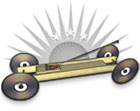Mousetrap Vehicles: Motion
Motion is typically described in terms of velocity, acceleration, displacement and time. Learn all about motion and how it applies to mousetrap powered vehicles.
Motion occurs all around us yet it is hard to describe and explain. More than 2000 years ago the Greeks try to describe motion but failed because they did not understand the concept of rate of change. Today we describe motion in terms of rates of change. We we use the term rate we are talking about changes in time.
s = d / t
speed: speed [s] is defined as distance [d] divided by time [t]. Speed is measured in meters per second, distance is measured in meters, and time is measured in seconds.
Speed is the measure of the distance that an object is covering per time where the word "per" means divided by. In most cases, when you calculate the speed of an object over a distance you are only calculating the average speed for that distance and not the instantaneous speed at any point along the distance; an odometer is used to tell the instantaneous speed at any moment in time of a vehicle's motion. In everyday conversations we tend to use the words speed and velocity interchangeably but speed and velocity are not the same and are slightly different from one another. Unlike speed knowing an objects velocity gives us a bit more information. Unlike speed, velocity includes the direction an object is heading; example, to say an objet is traveling at 55 mi/h is to give an object's speed only, but to say an object is traveling at 55 mi/h due north is to give the object's velocity. By adding the direction of an object motion we change our conversation from speed to velocity.
v = Δd / Δt
velocity: velocity [v] is defined as the change in distance [Δd] divided by the change in time [Δt] where the delta [Δ] always stands for a change. Velocity is measured in meters per second, distance is measured in meters, and time is measured in seconds.
Acceleration
Why is this small distinction of direction so important in the study of motion? If the velocity of an object is changing then there is another way to describe the objects motion and it is called acceleration, the rate at which velocity is changing. Velocity is changing when any of the following conditions occurs, there is a change in speed, or there is a change in direction. A car traveling in a circle at a constant speed has a changing direction so even though its speed is constant its direction is not, so it is accelerating.

bonus tip: a car traveling in a circle at a constant speed has a changing velocity because its direction is constantly changing. The car is accelerating towards the center.
Acceleration is something you can feel, when you step on the gas pedal or break pedal in a car you feel yourself accelerate. Also, when you turn the steering wheel of a car you change your direction and you feel acceleration so we say that accelerations are changes in speed and direction or changes in velocity. The rate at which velocity changes is call acceleration.
a = Δv / Δt
acceleration: acceleration [a] is defined as the change in velocity [Δv] divided by the change in time [Δt] where the delta [Δ] always stands for a change. Acceleration is measured in meters per second per second, distance is measured in meters, and time is measured in seconds.
*Can't find what you're looking for? Ask Doc Fizzix »




